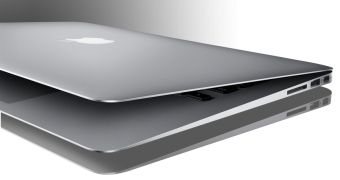Apple is replacing the aging Core 2 Duo processors inside its relatively new MacBook Air notebooks with the fresh Sandy Bridge architecture that features on-board graphics and Hyper-Threading support.
The ultra-thin notebooks are also getting Thunderbolt I/O technology from the same Apple partner, the Taiwan-based, industry trade publication DigiTimes reports.
While Apple already gave the MacBook Air a complete overhaul around six months ago, the super slim laptops that come in 11-inch and 13-inch configurations are using an old CPU architecture.
The big trend in Apple’s 2011 line of Macintosh computers is 'Sandy Bridge', a higher clocked processor architecture from Intel that boasts support for Hyper-Threading and works to save battery life - one of the top priorities for Apple’s thin laptops.
According to those who assemble Apple’s notebooks, the Taiwan-based supply chain for Apple products will begin shipments of new MacBook Air models in late May for launch in June or July
The supply chain sources said the new MacBook Airs would not only be featuring the Sandy Bridge platform, but also Intel’s Thunderbolt interface, also adopted by Apple in its MacBook Pros and, more recently, the all-in-one iMac.
Contacted for clarification on the matter, Apple's PR representatives in Taiwan declined to comment.
Originally codenamed Light Peak, Thunderbolt is an interface for connecting peripheral devices to a computer via an expansion bus.
It was first introduced (commercially) on Apple's updated MacBook Pro lineup earlier this year. One Apple’s notebooks, it uses the same port and connector as Mini DisplayPort and can drive data speeds of up to 10Gps.
Thunderbolt controllers fold data from existing DisplayPort systems with data from the PCI Express port into a single cable.
Apple recently modified the web page dedicated to talking about Thunderbolt technology to indicate that only 6 peripherals can be linked to a Thunderbolt port, and a Display at the end of the chain.

 14 DAY TRIAL //
14 DAY TRIAL //